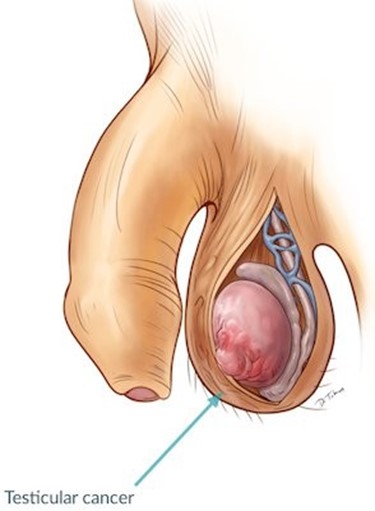A nurse is providing teaching for a client about testicular cancer. Which of the following manifestations should the nurse instruct the client to monitor for during self-examination?
A painless lump in the testicle.
Decreased size of the testicle.
Left testicle descending lower than right testicle.
Dilated veins above the testicle.
The Correct Answer is A
Choice A rationale:

Testicular cancer may present as a painless lump or swelling in the testicle. It's important for the client to monitor for any new or unusual lumps, as they could be indicative of cancer.
Choice B rationale:
A decreased size of the testicle is not a typical manifestation of testicular cancer. It is more commonly associated with conditions like testicular atrophy due to other causes.
Choice C rationale:
Asymmetry in the position of the testicles, with one testicle descending lower than the other, is a normal variation and not a sign of testicular cancer.
Choice D rationale:
Dilated veins above the testicle can be a sign of a varicocele, which is a separate condition from testicular cancer. It is caused by abnormal enlargement of veins in the scrotum and is generally not associated with cancer.
Nursing Test Bank
Naxlex Comprehensive Predictor Exams
Related Questions
Correct Answer is D
Explanation
Choice A rationale:
A PaO2 value of 86 mm Hg is within the normal range (80-100 mm Hg) and does not indicate respiratory acidosis. PaO2 measures the partial pressure of oxygen in arterial blood.
Choice B rationale:
A pH of 7.4 is within the normal range (7.35-7.45) and does not indicate respiratory acidosis. The pH reflects the acidity or alkalinity of the blood.
Choice C rationale:
An HCO3 (bicarbonate) level of 16 mEq/L is within the normal range (22-28 mEq/L) and does not indicate respiratory acidosis. HCO3 is a measure of the metabolic component of the body's acid-base balance.
Choice D rationale:
This is the correct choice. A PaCO2 value of 58 mm Hg is elevated and indicates respiratory acidosis. PaCO2 measures the partial pressure of carbon dioxide in arterial blood, and an elevated value suggests the presence of excess carbon dioxide, leading to acidosis.
Correct Answer is C
Explanation
Choice A rationale:
Assessing the need for oral suction every 4 hours is essential in maintaining airway patency and preventing complications associated with excessive secretions. This is an appropriate action and does not require clarification.
Choice B rationale:
Checking the ventilator settings every 12 hours is necessary to ensure that the mechanical ventilation is providing adequate support for the client's respiratory needs. This prescription is appropriate and does not need clarification.
Choice C rationale:
Keeping the head of the client's bed elevated at 30° is important in preventing aspiration and ventilator-associated pneumonia. This position helps promote optimal lung expansion and improves oxygenation in ventilated clients.
Choice D rationale:
Performing oral hygiene using an alcohol-based oral rinse is not recommended for clients receiving mechanical ventilation. Alcohol-based products can be harmful if aspirated and may disrupt the normal oral flora, leading to complications. The nurse should use a non-alcohol-based oral rinse or foam swabs instead.
Whether you are a student looking to ace your exams or a practicing nurse seeking to enhance your expertise , our nursing education contents will empower you with the confidence and competence to make a difference in the lives of patients and become a respected leader in the healthcare field.
Visit Naxlex, invest in your future and unlock endless possibilities with our unparalleled nursing education contents today
Report Wrong Answer on the Current Question
Do you disagree with the answer? If yes, what is your expected answer? Explain.
Kindly be descriptive with the issue you are facing.
